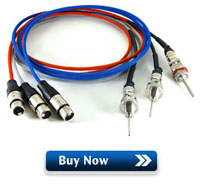Temperature Probes
 We use RTD (resistive thermal device) temperature probes in our brewery. Thermocouple (TC) based temperature probes are also readily available and are often used in brewing setups. While either will work, an RTD will typically be more accurate and remain more accurate over the brewing temperature range we use as it offers better linearity. RTDs also remain more accurate over time (less drift which means less re-calibration). The cost difference between the two is negligible in our setup.
We use RTD (resistive thermal device) temperature probes in our brewery. Thermocouple (TC) based temperature probes are also readily available and are often used in brewing setups. While either will work, an RTD will typically be more accurate and remain more accurate over the brewing temperature range we use as it offers better linearity. RTDs also remain more accurate over time (less drift which means less re-calibration). The cost difference between the two is negligible in our setup.
Temperature probes are used in the Hot Liquor Tank (HLT), Mash/Lauter Tun (MLT) , and Boil Kettle to send temperature readings back to our control panel:
- The Hot Liquor Tank probe monitors the water temperature so that the control panel knows when to fire the heating element to maintain the exact water temperature we set.
- The Mash/Lauter Tun probe monitors the temperature of the mash so that can see how fast the temperature rises. It does not actually control anything in our process but instead provides feedback as to how the brewing process is proceeding.
- The Boil Kettle probe monitors the wort temperature directly in the kettle so that the control panel knows when to fire the heating element used to boil the wort.
Temperature probes with NPT (tapered) threads attached to the Hot Liquor Tank and Mash/Lauter Tun output:
Temperature probe with a metric (straight) thread fastened to the Boil Kettle wall. (Note: The size of the silicone washer included with the probe has changed since this photo was originally taken):
The temperature probes for the Hot Liquor Tank and Mash/Lauter Tun are located in the plumbing at the kettle output while the Boil Kettle probe is installed directly in the kettle wall.
In process control systems such as ours that involve fluid recirculating, temperature monitoring is usually done in the plumbing instead of in the kettle. This helps avoid temperature misreads due to stratification (layering). This is not an issue in the Boil Kettle as the violent boiling action continuously stirs the wort to ensure an even temperature throughout the kettle.
Stratification is most likely to occur in the Mash/Lauter Tun. A temperature probe placed in the grain through the side of the kettle would only be measuring one location. We would not know when the entire grain bed is at the desired target temperature as it heats slowly from top to bottom. By placing the probe at the kettle output we ensure that the entire mash temperature is being monitored. For example, when we increase the Hot Liquor Tank temperature to 168F to perform a mashout, the water in the Hot Liquor Tank will reach 168F before the grain in the Mash/Lauter Tun. It is only when the Mash/Lauter Tun also reads 168F that we know that the whole grain bed is at 168F. Placing the probe elsewhere would not provide us with this accuracy.
The temperature probe bodies are made of stainless steel and come with a detachable connector at the probe end, making cleaning of the kettles much easier - you don't have to worry about damaging the probe cables. The 6 foot cables are teflon coated and rated to almost 600F.
Temperature probes as received:
 Just as we don't want cables dangling off the kettles as we try and clean them, we don't want the cables permanently attached to the control panel. Attaching small/thin cables permanently to anything big and heavy is simply asking for them to be ripped off by accident. We'll be adding 3-pin female XLR connectors which will allow the probes to be easily disconnected from the control panel if it ever needs to be moved.
Just as we don't want cables dangling off the kettles as we try and clean them, we don't want the cables permanently attached to the control panel. Attaching small/thin cables permanently to anything big and heavy is simply asking for them to be ripped off by accident. We'll be adding 3-pin female XLR connectors which will allow the probes to be easily disconnected from the control panel if it ever needs to be moved.
XLR connectors are widely used in professional audio and video electronics cabling applications for their ruggedness and locking capability (so that they don't pull out by accident).
The cables are fairly thin and flimsy so we're going to add a stainless steel wire rope to help protect them from accidental breaks.
The entire cable assembly will then be wrapped in two layers of expandable braided sleeving and black shrink wrap to protect it even further and give it more substantial weight and girth.
Temperature probes after modification:
The cables are protected with a stainless steel wire rope as strain relief and wrapped in two layers of expandable braided sleeving. A female XLR connector allows the probe to be disconnected from the control panel when required.
Close-up of the detachable connector at the probe end (Note: Probes today have 3 pins instead of 4):






